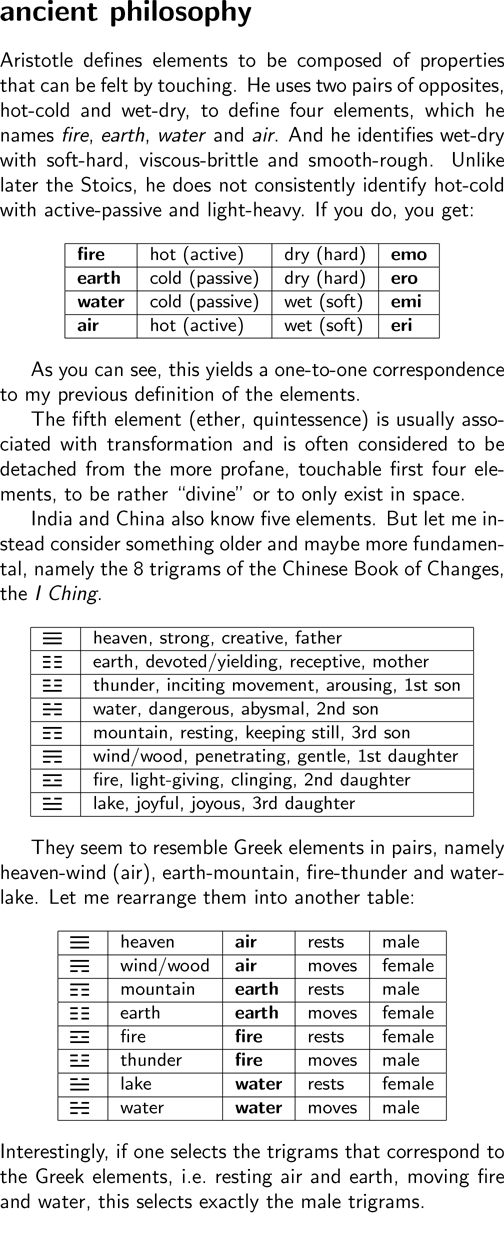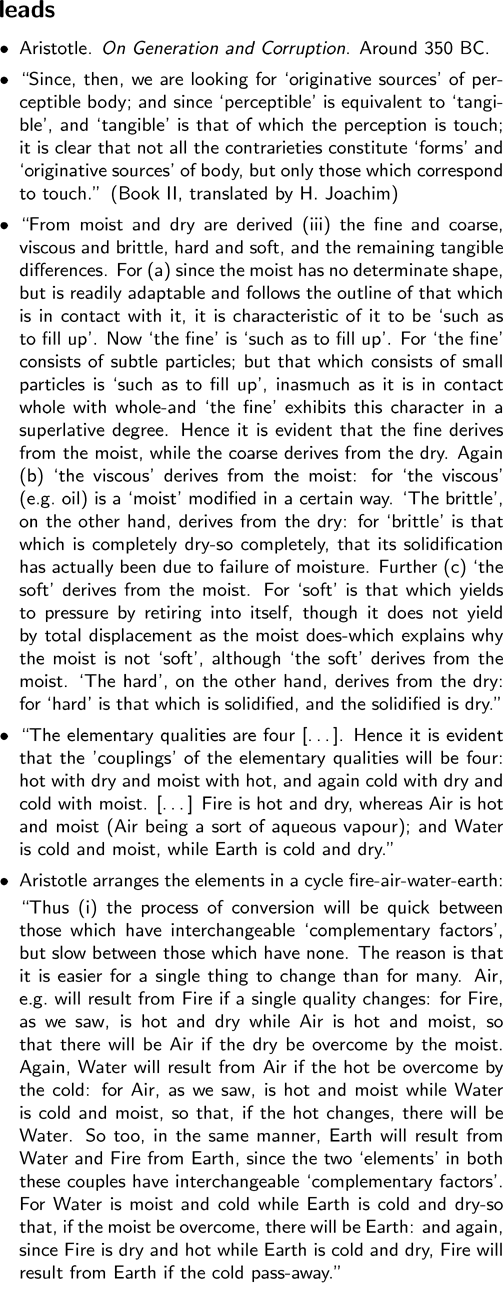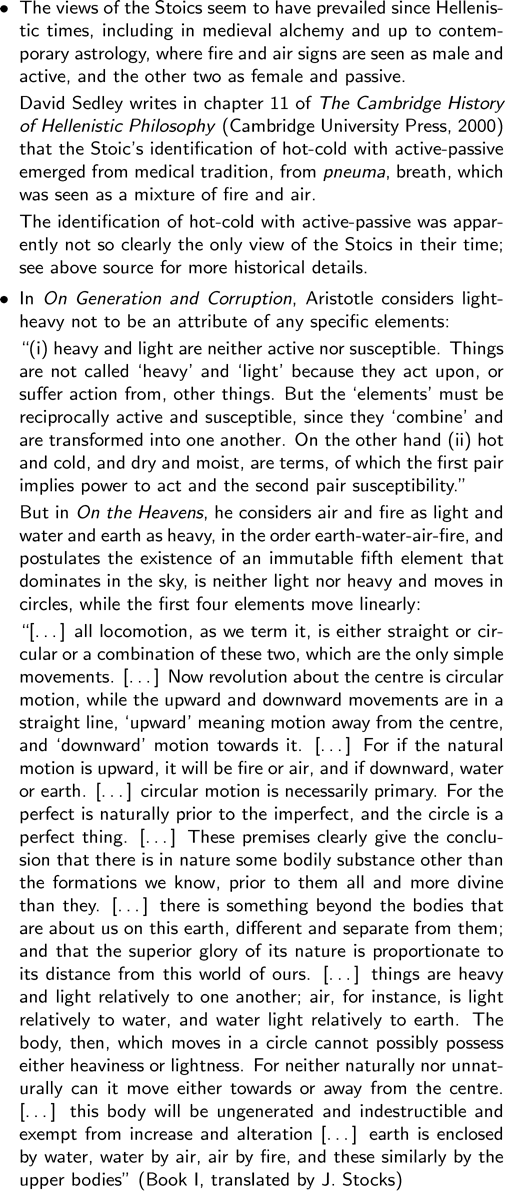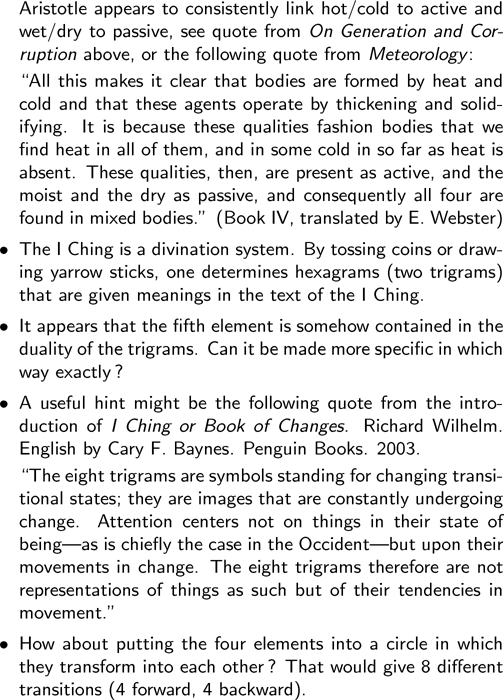|
|
ancient philosophy
Aristotle defines elements to be composed of properties
that can be felt by touching. He uses two pairs of
opposites, hot-cold and wet-dry, to define four elements,
which he names fire, earth,
water and air. And he identifies wet-dry
with soft-hard, viscous-brittle and smooth-rough. Unlike
later the Stoics, he does not consistently identify hot-cold
with active-passive and light-heavy. If you do, you get:
| fire |
hot (active) |
dry (hard) |
emo |
| earth |
cold (passive) |
dry (hard) |
ero |
| water |
cold (passive) |
wet (soft) |
emi |
| air |
hot (active) |
wet (soft) |
eri |
As you can see, this yields a one-to-one correspondence
to my previous definition of the elements.
The fifth element (ether, quintessence) is usually associated
with transformation and is often considered to be detached from
the more profane, touchable first four elements, to be rather
"divine" or to only exist in space.
India and China also know five elements. But let me instead
consider something older and maybe more fundamental, namely
the 8 trigrams of the Chinese Book of Changes, the I Ching.
| III |
heaven, strong, creative, father |
| ::: |
earth, devoted/yielding, receptive, mother |
| ::I |
thunder, inciting movement, arousing, 1st son |
| :I: |
water, dangerous, abysmal, 2nd son |
| I:: |
mountain, resting, keeping still, 3rd son |
| II: |
wind/wood, penetrating, gentle, 1st daughter |
| I:I |
fire, light-giving, clinging, 2nd daughter |
| :II |
lake, joyful, joyous, 3rd daughter |
Seems they resemble the Greek elements in pairs,
namely heaven-wind (air), earth-mountain, fire-thunder and
water-lake. Let me rearrange them into another table:
| III |
heaven |
air |
rests |
male |
| II: |
wind/wood |
air |
moves |
female |
| I:: |
mountain |
earth |
rests |
male |
| ::: |
earth |
earth |
moves |
female |
| I:I |
fire |
fire |
rests |
female |
| ::I |
thunder |
fire |
moves |
male |
| :II |
lake |
water |
rests |
female |
| :I: |
water |
water |
moves |
male |
Interestingly, if one selects the trigrams that correspond
to the Greek elements, i.e. resting air and earth, moving
fire and water, this selects exactly the male trigrams.
leads
- Aristotle. On Generation and Corruption. Around 350 BC.
-
"Since, then, we are looking for 'originative sources' of
perceptible body; and since 'perceptible' is equivalent to 'tangible',
and 'tangible' is that of which the perception is touch; it is clear
that not all the contrarieties constitute 'forms' and 'originative
sources' of body, but only those which correspond to touch."
(Book II, translated by H. Joachim)
-
"From moist and dry are derived (iii) the fine and coarse,
viscous and brittle, hard and soft, and the remaining tangible
differences. For (a) since the moist has no determinate shape,
but is readily adaptable and follows the outline of that which
is in contact with it, it is characteristic of it to be 'such as
to fill up'. Now 'the fine' is 'such as to fill up'. For 'the fine'
consists of subtle particles; but that which consists of small
particles is 'such as to fill up', inasmuch as it is in contact
whole with whole-and 'the fine' exhibits this character in a
superlative degree. Hence it is evident that the fine derives
from the moist, while the coarse derives from the dry. Again
(b) 'the viscous' derives from the moist: for 'the viscous'
(e.g. oil) is a 'moist' modified in a certain way. 'The brittle',
on the other hand, derives from the dry: for 'brittle' is that
which is completely dry-so completely, that its solidification
has actually been due to failure of moisture. Further (c) 'the
soft' derives from the moist. For 'soft' is that which yields
to pressure by retiring into itself, though it does not yield
by total displacement as the moist does-which explains why
the moist is not 'soft', although 'the soft' derives from the
moist. 'The hard', on the other hand, derives from the dry: for
'hard' is that which is solidified, and the solidified is dry."
-
"The elementary qualities are four [...]. Hence it is evident
that the 'couplings' of the elementary qualities will be four:
hot with dry and moist with hot, and again cold with dry and
cold with moist. [...] Fire is hot and dry, whereas Air is hot
and moist (Air being a sort of aqueous vapour); and Water
is cold and moist, while Earth is cold and dry."
-
Aristotle arranges the elements in a cycle fire-air-water-earth:
"Thus (i) the process of conversion will be quick between
those which have interchangeable 'complementary factors',
but slow between those which have none. The reason is that
it is easier for a single thing to change than for many. Air,
e.g. will result from Fire if a single quality changes: for Fire,
as we saw, is hot and dry while Air is hot and moist, so
that there will be Air if the dry be overcome by the moist.
Again, Water will result from Air if the hot be overcome by
the cold: for Air, as we saw, is hot and moist while Water
is cold and moist, so that, if the hot changes, there will be
Water. So too, in the same manner, Earth will result from
Water and Fire from Earth, since the two 'elements' in both
these couples have interchangeable 'complementary factors'.
For Water is moist and cold while Earth is cold and dry-so
that, if the moist be overcome, there will be Earth: and again,
since Fire is dry and hot while Earth is cold and dry, Fire will
result from Earth if the cold pass-away."
-
The views of the Stoics seem to have prevailed since
Hellenistic times, including in medieval alchemy and up to
contemporary astrology, where fire and air signs are seen
as male and active, and the other two as female and passive.
David Sedley writes in chapter 11 of The Cambridge
History of Hellenistic Philosophy (Cambridge University Press, 2000)
that the Stoic's identification of hot-cold with active-passive
emerged from medical tradition, from pneuma, breath,
which was seen as a mixture of fire and air.
The identification of hot-cold with active-passive was apparently
not so clearly the only view of the Stoics in their time;
see above source for more historical details.
-
In On Generation and Corruption, Aristotle considers
light-heavy not to be an attribute of any specific elements:
"(i) heavy and light are neither active nor susceptible. Things
are not called 'heavy' and 'light' because they act upon, or
suffer action from, other things. But the 'elements' must be
reciprocally active and susceptible, since they 'combine' and
are transformed into one another. On the other hand (ii) hot
and cold, and dry and moist, are terms, of which the first pair
implies power to act and the second pair susceptibility."
But in On the Heavens, he considers air
and fire as light and water and earth as heavy, in the order
earth-water-air-fire, and postulates the existence of an immutable
fifth element that dominates in the sky, is neither light
nor heavy and moves in circles, while the first four
elements move linearly:
"[...] all locomotion, as we term it, is either straight or
circular or a combination of these two, which are the only simple
movements. [...] Now revolution about the centre is circular
motion, while the upward and downward movements are in a straight
line, 'upward' meaning motion away from the centre, and 'downward'
motion towards it. [...] For if the natural motion is upward,
it will be fire or air, and if downward, water or earth. [...]
circular motion is necessarily primary. For the perfect is
naturally prior to the imperfect, and the circle is a perfect
thing. [...] These premises clearly give the conclusion that
there is in nature some bodily substance other than the
formations we know, prior to them all and more divine than they.
[...] there is something beyond the bodies that are about us
on this earth, different and separate from them; and that the
superior glory of its nature is proportionate to its distance
from this world of ours. [...] things are heavy and light
relatively to one another; air, for instance, is light relatively
to water, and water light relatively to earth. The body, then,
which moves in a circle cannot possibly possess either heaviness
or lightness. For neither naturally nor unnaturally can it move
either towards or away from the centre. [...] this body will
be ungenerated and indestructible and exempt from increase and
alteration [\ldots] earth is enclosed by water, water by air,
air by fire, and these similarly by the upper bodies''
(Book I, translated by J. Stocks)
Aristotle appears to consistently link hot/cold to active and
wet/dry to passive, see quote from On Generation and Corruption
above, or the following quote from Meteorology:
"All this makes it clear that bodies are formed by heat and
cold and that these agents operate by thickening and solidifying.
It is because these qualities fashion bodies that we find heat
in all of them, and in some cold in so far as heat is absent.
These qualities, then, are present as active, and the moist and
the dry as passive, and consequently all four are found in
mixed bodies." (Book IV, translated by E. Webster)
-
The I Ching is a divination system. By tossing coins or
drawing yarrow sticks, one determines hexagrams (two trigrams)
that are given meanings in the text of the I Ching.
-
It appears that the fifth element is somehow contained in the
duality of the trigrams. Can it be made more specific in which
way exactly ?
-
A useful hint might be the following quote from the
introduction of I Ching or Book of Changes.
Richard Wilhelm. English by Cary F. Baynes. Penguin Books. 2003.
"The eight trigrams are symbols standing for changing
transitional states; they are images that are constantly undergoing
change. Attention centers not on things in their state of
being - as is chiefly the case in the Occident - but upon their
movements in change. The eight trigrams therefore are not
representations of things as such but of their tendencies in
movement."
-
How about putting the four elements into a circle
in which they transform into each other ? That would give
8 different transitions (4 forward, 4 backward).
|


















